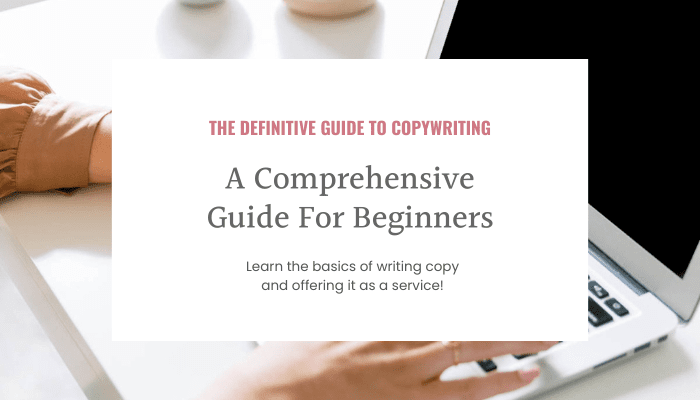How To Successfully Transition Into Copywriting (Step-By-Step Plan)
A step-by-step plan to start a copywriting business, even if you’re busy with a 9-5 job.
If you want to start a copywriting business but are wondering how you can possibly do it while working a 9-5 job, this blog post will tell you everything you need to know about how to transition into copywriting successfully.
I’ll cover:
- How to make time in your schedule (even if you think you don’t have any)
- A step-by-step action plan so you don’t get overwhelmed
- How to develop your copywriting skills
- How to manage clients while working a day job
- How to transition into copywriting full time
Let’s get started…
Is Copywriting Right For You?
If you’re dancing with the idea of being a copywriter but not ~quite~ sure if it’s right for you, ask yourself:
- Do you like to write?
- Do you like marketing?
- Are you willing to work on your skills?
- Do you want to make a full time income working part time hours?
If you answered yes to those questions, you’ll probably love being a copywriter.
Seriously. It’s the best job ever.
You help your clients make more money. They pay you well. Everybody gets to thrive.
And if you have kids (or want to in the future), it’ll help you design a business that’s compatible with nurturing a family.
Cause’ seriously…we don’t live to work. We work to live a better life. Right?
How To Make Time in Your Schedule for Your Freelance Copywriting Business
Running a business can feel overwhelming, especially if you’re already trying to “show up” in multiple areas of your life. So you’re probably wondering how you can even find time to start a copywriting business when your life is so full already.
Maybe you struggle as it is to carve time in your day for all the things you want to do, on top of binge-watching Youtube videos on how to start your new side hustle.

I get it.
Benjamin Franklin once said, “If you fail to plan, you plan to fail.”
If you want to start a copywriting business, you need an actionable plan in place (which I’m going to give you next).
The first step in this plan is simply making time for your business—and if that feels hard, I’m going to share the hacks that helped me make time for my business as a busy wife and mom.
Conduct A Time Audit
When people low on funds, one of the the first thing they usually do is audit their spending. The same principle goes for your time.
A time audit is a great way to examine your day. It helps you get a bigger picture of how you’re actually spending your time versus how you *intend* to spend your time.
We don’t realize how many minutes are wasted on distractions (like scrolling social media 👀) until we make audit how we’re “spending” our time.
Here’s how you do it…
Write down the urgent tasks you have to accomplish during your week (the non-negotiables).
Then track all your time to see where your time is actually going. If you’re not a fan of pen and paper, try using an online calendar, spreadsheet or a free time tracking app like Clockify. You can also use Google Sheets or the notes app on your phone.
You might notice you’re spending unnecessary time on tasks that can be cut out, and that will give you more room to spend on your copywriting business.
Use Time Blocking
Now that you’ve audited your time, you can find gaps in your schedule to dedicate to your business and create a manageable schedule.
That’s where time blocking comes in!
Time blocking is simply breaking down your day into blocks of time, and then assigning yourself tasks to focus on during those blocks.
Time blocking will help you find gaps of time you can use to work on your skills, email cold pitches to prospective clients and even collaborate with other copywriters.
It can be 15 minutes, 30 minutes, or 2 hours. Whatever time you have, you can make it work.
When done properly, time blocking will show you how much time you have to assign towards your priorities. It’s really the secret sauce on how to successfully transition into copywriting if you’re already busy with a 9-5 job.
It’s time to plan your life on purpose 💃.
List Your Priorities
Have you ever spent hours on a non-urgent task, and then realized it could’ve been done later?
(Yeah, me neither 🙃)
Prioritizing tasks can feel overwhelming when everything seems urgent, but it’s a must if you want to meet your deadlines. It’ll ease the stress of managing clients on top of your 9-5 job.
Ask yourself which tasks should be done first, which can be delegated, or even wait until later.
And pro tip…
If your most productive time is in the morning, try moving the more time consuming or urgent tasks before your lunch break. That way you can give your best to what’s most important.
If you have a long to-do list, it’s easy to get bogged down by the workload. Get the meatier tasks out of the way, and it’ll motivate you to move on to the smaller ones because the “giants” tasks are out of the way.
Develop Your Copywriting Skills
Once you have a schedule in place, you’ll have time set aside to work on your copywriting skills (which is the most important place to start with your business).
In my Definitive Guide to Copywriting, I talk about how to develop your skills as a copywriter. That’s a great place to start if your new to copywriting.
I also recommend reading books about copywriting.
One of the best ways to stand out as a copywriter is to learn everything you can about the industry. The more you refine your skills, the more value you bring to your future clients (and you’ll continue getting more work).
Don’t make the same mistake I see new writers make—focusing only on copywriting as a business, and not investing in their skills to do the work well.
Yes, you need both. But you can’t produce results for your clients if you don’t develop your skills first.
You can also choose to niche your skill set in a certain form of copywriting. Specializing your copywriting is one way to position yourself as an expert. You might choose to specialize in website copy, ads, email sequences, or sales pages. But you definitely don’t have to (especially at first).
To learn more about the different forms of copy that can make you a profitable copywriter, check out my free copywriting class.
Create A Business Plan
Before you start a copywriting business, it’s important to create a plan. Remember, your plan is your roadmap to success!
Develop a “plan of action” that clearly outlines your goals, business strategy, and target clients.
Here’s a “template” to get you started:
#1 Choose Your Services
There’s tons of “micro-niches” inside of copywriting itself. You might start out offering all of these services, but only to a specific clientele (i.e. doctors, lawyers or etc)…or you might decide to specialize from the start.
It’s your biz, so you make the rules.
Either way, here are some copywriting services you can offer:
Consulting
For clients who don’t know where to start, offering consulting services is a lower barrier to entry and builds “know, like, and trust.”
(Seriously, if you do it right…you can upsell your consulting client to purchase your copy services. It’s great.)
I offer 60-minute intensives in my agency. It’s not a main offer, but I do include it in my proposals as an add-on service.
Web Copy
This can include copy for landing pages, sales pages, or website copy.
Email Copy
Email copy is one of my favorite copy formats! You can create retainer packages for weekly newsletters or write email sequences for a sales funnel.
Ad Copy
You can niche as an ad copywriter or add it to your suite of services. This might include digital ads for social media or Google—or print ads for magazines, billboards, or etc.
You can “bundle” some of these services together to create a higher-priced package as well.
#2 Choose Your Client Avatar
A good friend of mine once said, when you’re writing to everyone you’re writing to no one. The same is true with your business, and that’s why having a client avatar or “ideal client” really helps narrow down your marketing efforts.
A client avatar is the profile of the kind of client you want to work with. Who are they? What do they do? What do they need help with?
When you’re starting out, you might not know who you want to target just yet—but I highly suggest starting out with markets that you have some experience (or interest) in.
With time, you’ll have a better idea of how who you want to work with, what services you want to offer, and it’ll be easier to niche down your brand.
#3 Establish Your Rates & Packages
Now that you know what services you want to offer and who you’d like to work with, you need to decide what you’ll charge for your copy services.
Starting out, you might not know what to charge (most of us don’t). Here is a formula you can use to quote any copywriting project that comes your way:
You multiply your internal hourly rate by the number of hours you expect the project to take you.
(Your “internal” hourly rate is what you want to make per hour, but you don’t share this with your client.)
When deciding your internal hourly rate, think about your skill level, past experience, and what you need to make to cover your expenses.
Here’s an idea of what you can charge bsed on your experience and skill level:
#4 Create Writing Samples
If you’ve never written copy for a client before, you want to create samples to show the work you do.
Whatever kind of copy you want to write, make sure you have at least 3 samples of it. If you want to write various kinds of copy, then you can come up with a mix of writing formats (for example, a sales email, a home page copy, and an ad).
If you can do more than 3, that’ll show more variety and help you practice your copywriting (so even better).
In my free copywriting class, I share some more copywriting techniques that you can use to create your samples and set your rates!
#5 Buy A Legal Contract
While this isn’t necessarily critical to booking a client, I would recommend having one in place. It’ll protect both you and your client, and make you look professional.
You can check out this contract for freelancers from The Contract Shop.
Contracts aren’t cheap, so it’s something you’ll want to save for. If you’re not able to make the investment right away, you can wait until you have a couple of projects under your belt to cover the expense.
The good thing is it will be a tax write-off for your business, and you only pay once to use it “forever.”
#6 Establish A Client Process
Before you actually sign a client, you want to create processes for writing copy and onboarding your clients.
You also want to decide what to use to send invoice and accept payments (i.e. Stripe or PayPal).
Starting out, your process might be really simple and that’s totally fine. You just want to have something in place so that when you sign on a client, you can walk them through your process and not seem disorganized.
Here’s an example of what your process *might* look like for new leads:
- A potential client books a discovery call with you
- If they’re a good fit, you follow up with a proposal
- Once they accept your proposal, they will need to sign a contract and pay a deposit using Stripe to work with you
After that, you’ll have more steps once the client books and you start on the project.
(To look behind the scenes at my copywriting process, check out my free copywriting class here.)
As you work with more clients, you’re going to tweak your process based on feedback from your clients, and what works best for your business.
#7 Make A List Of Potential Clients
Cold pitching is how I got my first client, and it’s what I recommend for new copywriters as well.
Most people don’t like to hear that advice. They’d rather have a bunch of ideal clients chasing them down (wouldn’t we all?).
But here’s the thing…
You can get to that point, but in the beginning, it’s not going to happen that way. There’s no way around it…you have to market yourself.
Do a little research on Google, and find businesses in the industries you’d like to write for. Make note of their website, social media handles, and contact information. (I recommend doing this on a spreadsheet.)
If you need some ideas, check out my list of 100 Client Niches For Copywriters.
#8 Pitch Your Services
Once you’ve done your research on what clients to pitch to, create 2-3 templates you can use as a starting point for your pitches.
Then, actually send the pitch.
(If you’d like to see an exact copy of the pitch I use in my agency, check out my *free* email pitch template here.)
I recommend sending 5-10 pitches a week consistently (if you want to see results). All it takes is sending 1-2 pitches a day to meet that goal 👏.
How To Work With Clients When You Have A 9–5
If you have a full time job or need to make money as you build your copywriting business, you may have to juggle your client work while you’re employed.
It’s very possible to do, it just takes some organization on your end. Here’s a few tips to successfully manage your clients while you’re employed.
Decide How Many Billable Hours You Can Work
Make sure you establish how many hours you have per week to actually work on client projects.
These are called billable hours, because it’s the time you’re “billing” clients for. It doesn’t include the time you spend working on your own business (things like admin, marketing and etc).
At first, you might only have 1-2 hours a day during weekdays, and extra time on the weekends to get things done.
As your business grows, you’ll get to a point where you can run your business full time (if that’s your goal).
Tell Clients How You Work
You don’t have to tell clients about your 9-5 (unless they ask), but I do recommend setting expectations up front.
Things like:
- How should they contact you? (i.e. email, Slack, Voxer?)
- How often will you update them on the project? (I suggest 1-2 times a week)
- How long does it take for you to respond to emails? (I suggest 24-48 hours on weekdays)
- When are you available for meetings? (If you have a 9-5, propose Saturdays or suggest Voxer as an alternative)
- What’s the timeline for the project? (Create a realistic deadline based on how much time you expect it to take you and how many hours per week you have to work.)
How To Transition Into Working Full Time on Your Business
If you want to become a full-time copywriter, I don’t recommend quitting your 9-5 right away (I don’t want you to feel desperate for clients—it’ll show).
Before you give your two weeks notice, there’s a few things that’ll make the transition easier and help you feel more comfortable financially. More on that next.
Save An Emergency Fund
Business can be unpredictable at times, and you want to make sure you and your family are covered if you have a slower month in your business.
Try to save up a couple of months of expenses, and if you’re not able to right away, save it gradually as your business revenue increases.
Pick A business model
Will you write all the copy yourself? What if you get more work than you can handle? Will you have a waitlist or outsource more copywriters?
Do you want an agency model for your copywriting business (meaning other copywriters will work under you)?
Deciding your business model upfront will help you organize a plan (remember we talked about planning?) and take the needed steps.
Create A Referral System
Clients who come in as referrals are almost always the best clients (in my experience). Having a solid referral system in place will ensure more work is coming your way on a continual basis.
Will you offer an incentive if someone refers you work? Will you connect with other freelancers that you can share referrals with?
Decide on your referral system and a strategy for getting more referrals. It’ll make your transition a lot easier if you have consistent work coming in.
Create Systems For Your Business
Systems is just a fancy word for the way you do things in your business.
You need some laws n’ order in place if you want your business to run smoothly. And here’s why…
One of the hardest things about transitioning from being an employee to owning your own business, is you don’t have anyone telling you what to do. (Gasp, I know.)
The idea of being your own boss sounds great at first…
Until you’re staring at a blank screen, scratching your earlobe, wondering if you should be posting on social media, sending cold emails, or practicing your writing skills…and in what order.
It will help to create a list of daily, weekly, and monthly tasks with deadlines. The tasks can be simple starting out, so don’t get overwhelmed with it.
Some tasks might include:
- Send cold emails to 5 businesses
- Add 5 new connections on LinkedIn
- Write 3 posts for LinkedIn
- Follow up on emails
- Create a MailerLIte account to start an email list
Also, create step by step instructions (also known as standard operating procedures) for different tasks in your business.
What’s your process for writing emails? What steps do you take to find potential clients? Whatever it is, write it down!
You might not think it’s important while you’re working solo, but as soon as you bring on a team member you’re going to feel the burn if you don’t have these systems in place. They’ll have no idea how you run your biz, and you’ll spend a lot of time trying to explain everything.
Conclusion On How To Successfully Transition Into Copywriting
Copywriting is a great premium service to offer clients. If you’re already a virtual assistant or freelance writer, it’s worth making the transition into copywriting as your niche.
Let me know in the comments, do you think a copywriting business is a right fit for you? Why or why not?
Looking for more?
Download my Definitive Guide To Copywriting (it’s free)
Download my free email pitch template
100 Client Niches For Copywriters








Love this list! I definitely needed something like this when I was getting started as a freelancer!
Honestly, same!! Hopefully it’ll help others make progress more quickly!
Wow! Such a detailed and valuable posts. I have played with the thought of copywriting, but never really informed myself. Your post is so easy to follow that I might give it a go. Thank You!
You’re so welcome! You should definitely try it if you like writing – I have tons of free resources to help you get started. Glad this helped!
What a great resource! Thanks for sharing! 🙂
You’re so welcome Liza! I’m always happy to help 🙂